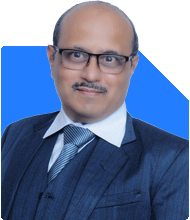Retirement Planning: 48-Year-Old with Rs.2.5 Lakh Monthly Target
Ramalingam Kalirajan |10893 Answers |Ask -Follow
Mutual Funds, Financial Planning Expert - Answered on Aug 14, 2024
He has an MBA in finance from the University of Madras and is a certified financial planner.
He is the director and chief financial planner at Holistic Investment, a Chennai-based firm that offers financial planning and wealth management advice.... more

Hello , My age is 48 years, monthly income is approx. 1.5 lakh, I have no loan and any liability. I have 3 lakh in Shares , approx 30 lakh in PPF, 35 lakh in FDR , approx 3 lakh in saving., 60 lakh in NPS and Rs 48000/- per month NPS contribution, 5 lakh in SGB, what will my financial plan for retirement income of 2.5 lakh- per month
Shares: Rs 3 lakh
PPF: Rs 30 lakh
FDR: Rs 35 lakh
Savings: Rs 3 lakh
NPS: Rs 60 lakh with a monthly contribution of Rs 48,000
SGB: Rs 5 lakh
With no liabilities or loans, you’re in a favourable position to plan for your retirement. Your goal of achieving a retirement income of Rs 2.5 lakh per month is ambitious, yet achievable with careful planning and strategic investments.
Assessing Your Retirement Goals
Retiring with a monthly income of Rs 2.5 lakh requires substantial planning. Here’s what you need to consider:
Inflation: Over the next few years, inflation will erode the purchasing power of your money. A monthly income of Rs 2.5 lakh today might need to be much higher by the time you retire.
Life Expectancy: Considering an average life expectancy of 80 years, your retirement plan should be robust enough to last for at least 30-35 years.
Healthcare Costs: With age, healthcare expenses will increase. It’s essential to allocate funds specifically for medical emergencies.
Lifestyle: If you plan to maintain or even enhance your current lifestyle, your retirement corpus should be sizeable enough to support this.
Evaluating Your Current Investments
Your investments are spread across different instruments, each with its benefits and limitations. Let’s evaluate them:
Public Provident Fund (PPF)
Advantages: PPF is a safe investment with a decent interest rate, and it’s tax-free.
Limitations: The lock-in period and the maximum contribution limit restrict how much you can invest.
Recommendation: Continue contributing to PPF, but don’t rely on it solely for retirement. PPF will provide stability, but it won’t be enough to meet your Rs 2.5 lakh per month target.
Fixed Deposit Receipts (FDR)
Advantages: FDs offer guaranteed returns and are a safe investment option.
Limitations: The interest rates on FDs are often lower than inflation, leading to a decrease in real returns over time.
Recommendation: While FDs are good for short-term goals and emergencies, they shouldn’t be your primary retirement investment. Consider reallocating a portion of this into higher-return investments.
National Pension Scheme (NPS)
Advantages: NPS is a robust retirement savings tool, offering market-linked returns and tax benefits.
Limitations: NPS has restrictions on withdrawals and requires annuitisation at maturity, which might reduce liquidity.
Recommendation: Continue your contributions to NPS, but plan for how you’ll manage the annuity phase. The lump-sum withdrawal option should be carefully managed.
Sovereign Gold Bonds (SGB)
Advantages: SGBs offer a safe way to invest in gold with an interest component.
Limitations: Gold is typically seen as a hedge rather than a primary investment for income generation.
Recommendation: Keep SGBs as part of your diversified portfolio but avoid over-investing in gold. It’s more of a safety net than a growth tool.
Shares
Advantages: Equities can provide high returns and help in wealth accumulation.
Limitations: Shares are volatile and require careful management to avoid losses.
Recommendation: Your equity investment is relatively low. Consider gradually increasing your exposure to equities through mutual funds or systematic investment plans (SIPs) for long-term growth.
Strategic Rebalancing of Your Portfolio
To meet your retirement goal of Rs 2.5 lakh per month, you’ll need to rebalance your portfolio strategically. Here’s how you can do it:
Increase Equity Exposure
Reason: Equities have the potential to outpace inflation and generate significant returns over the long term.
Action: Consider investing in diversified equity mutual funds or SIPs. Over the next 10-12 years, this will help build a robust corpus.
Maximise NPS Benefits
Reason: NPS is tax-efficient and offers good returns, especially with equity exposure.
Action: Continue your Rs 48,000 monthly contribution. At retirement, plan to manage the withdrawal carefully, considering both the annuity and lump-sum options.
Reduce Fixed Deposit Allocation
Reason: FDs offer lower returns compared to other investment options.
Action: Gradually shift a portion of your FD savings into equity or balanced mutual funds. This will help grow your corpus faster.
Maintain a Balanced Portfolio
Reason: Diversification reduces risk and ensures stability.
Action: Keep a mix of equities, debt, gold, and NPS. This balanced approach will protect you against market volatility while ensuring growth.
Planning for Healthcare and Contingencies
Healthcare is a significant concern during retirement. Here’s how you can prepare:
Emergency Fund: Maintain at least 6-12 months’ worth of expenses in liquid savings for emergencies.
Health Insurance: Ensure you have comprehensive health insurance coverage. Consider a top-up plan if needed.
Medical Corpus: Set aside a dedicated corpus for healthcare. This could be in the form of a health savings account or a specific investment geared towards medical expenses.
Ensuring a Steady Retirement Income
To achieve a retirement income of Rs 2.5 lakh per month, consider the following strategies:
Systematic Withdrawal Plan (SWP)
Advantages: SWP from mutual funds allows you to withdraw a fixed amount regularly while the rest of your investment continues to grow.
Action: Set up SWPs from your equity and debt mutual funds. This will provide you with a steady income while ensuring your corpus continues to work for you.
Annuities and Pensions
Advantages: Annuities provide a guaranteed income for life.
Limitations: Annuities can have lower returns compared to other investments and may not keep pace with inflation.
Action: Use a portion of your NPS maturity amount to purchase an annuity for guaranteed income. However, balance this with other investments to ensure inflation-adjusted growth.
Realigning Investments Closer to Retirement
Reason: As you approach retirement, reducing exposure to high-risk investments is crucial.
Action: Gradually shift from equity to more stable debt instruments or balanced funds as you near retirement. This will protect your corpus from market volatility.
Final Insights
Your financial foundation is strong, with diversified investments and no liabilities. However, to achieve your goal of a Rs 2.5 lakh monthly income during retirement, you’ll need to make strategic adjustments to your portfolio.
Here are the key takeaways:
Increase Equity Exposure: Focus on long-term growth through diversified equity mutual funds or SIPs. This will help build the corpus you need.
Maximise NPS: Continue your contributions and plan for strategic withdrawals at retirement.
Reduce Fixed Deposits: Shift from low-return FDs to higher-yield investments like mutual funds or equities.
Maintain a Balanced Portfolio: Ensure diversification to reduce risk while maintaining growth.
Plan for Healthcare: Set aside a dedicated medical corpus and ensure you have adequate health insurance.
Use Systematic Withdrawal Plans (SWPs): This will provide a steady retirement income while keeping your investments growing.
Consider Annuities: Use part of your NPS maturity to purchase an annuity for guaranteed income, but don’t rely solely on it.
Realign Investments Closer to Retirement: Gradually reduce risk as you approach retirement to protect your corpus.
By carefully planning and making these adjustments, you can achieve your retirement goal and enjoy a comfortable, worry-free retirement.
Best Regards,
K. Ramalingam, MBA, CFP,
Chief Financial Planner,
www.holisticinvestment.in
You may like to see similar questions and answers below
Ramalingam Kalirajan |10893 Answers |Ask -Follow
Mutual Funds, Financial Planning Expert - Answered on Jul 25, 2024
Ramalingam Kalirajan |10893 Answers |Ask -Follow
Mutual Funds, Financial Planning Expert - Answered on Aug 14, 2024
Ramalingam Kalirajan |10893 Answers |Ask -Follow
Mutual Funds, Financial Planning Expert - Answered on Sep 24, 2024
Nitin Narkhede |113 Answers |Ask -Follow
MF, PF Expert - Answered on Dec 15, 2025
Nitin Narkhede |113 Answers |Ask -Follow
MF, PF Expert - Answered on Dec 15, 2025
Ramalingam Kalirajan |10893 Answers |Ask -Follow
Mutual Funds, Financial Planning Expert - Answered on Dec 15, 2025
Ramalingam Kalirajan |10893 Answers |Ask -Follow
Mutual Funds, Financial Planning Expert - Answered on Dec 15, 2025
Radheshyam Zanwar |6746 Answers |Ask -Follow
MHT-CET, IIT-JEE, NEET-UG Expert - Answered on Dec 15, 2025
Ramalingam Kalirajan |10893 Answers |Ask -Follow
Mutual Funds, Financial Planning Expert - Answered on Dec 15, 2025
Ramalingam Kalirajan |10893 Answers |Ask -Follow
Mutual Funds, Financial Planning Expert - Answered on Dec 15, 2025
Ramalingam Kalirajan |10893 Answers |Ask -Follow
Mutual Funds, Financial Planning Expert - Answered on Dec 15, 2025
Samraat Jadhav |2508 Answers |Ask -Follow
Stock Market Expert - Answered on Dec 15, 2025
Ramalingam Kalirajan |10893 Answers |Ask -Follow
Mutual Funds, Financial Planning Expert - Answered on Dec 15, 2025























